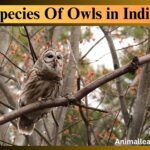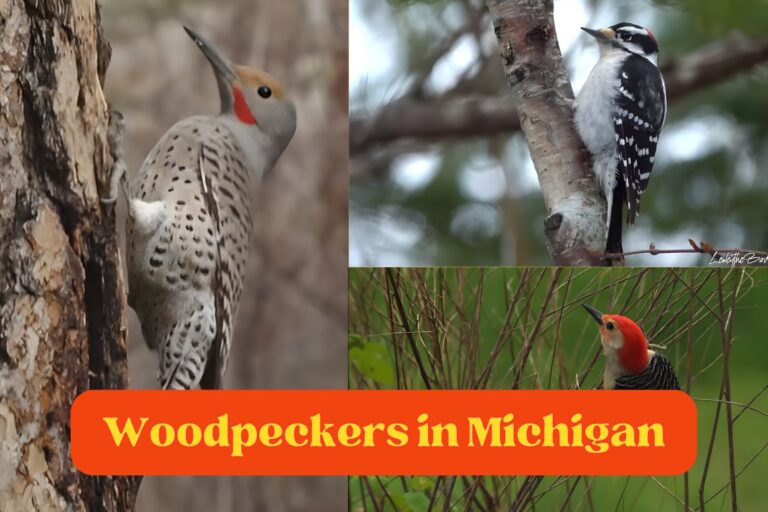11 Owls of Wisconsin (With Picture) – Animallearns

Owls of Wisconsin, with their sharp eyes and quiet wings, are a kind of sentry that guards the secrets of the marshes and woodlands at night. Their haunting cries color the night sky.
There are 19 distinct species of owls in the United States, and Wisconsin is home to 11 of these species because of the state’s climate and biodiversity, making it one of the owl-richest states in the nation!
The size, form, and lifestyle of the owls that inhabit Wisconsin vary widely. Wisconsin is home to a large number of common owls, but its woodlands also harbor some of the state’s rarest species.
These creatures, who often reside far into the woods, have some unearthly sounds that, should you happen upon them, will make any birding excursion worthwhile.
This page will examine Wisconsin’s 11 recognized owl species, including information on their habitats and methods of detection.
Owls Of Wisconsin
Contents
- Great Horned Owl
- American Barn Owl
- Barred Owl
- Eastern Screech Owl
- Long-eared Owl
- Great Gray Owl
- Short-eared Owl
- Northern Saw-whet Owl
- Snowy Owl
- Northern Hawk Owl
- Boreal Owl (Rare)
Great Horned Owl

- Scientific name – Bubo virginianus
- Lifespan – 13 years (average), 28 years (maximum recorded)
- Size – 18.1 to 24.8 in (46 to 63 cm)
- Weight – 32.1 to 88.2 oz (910 to 2500 g)
- Wingspan – 39.8 to 57.1 in (101 to 145 cm)
One of the most versatile birds in North America, the Great Horned Owl may be found from northern Alaska to southern Brazil. It can live in woods, meadows, marshes, deserts, and even cities.
Being a nocturnal species, the Great Horned Owl spends its days sleeping and is active throughout the night hunting. With its mottled brown feathers, this owl is equipped for camouflage, which helps it blend in with the environment.
The Great Horned Owl’s strong, heavily feathered legs are designed for quiet stalking and lethal pounces.
The purpose of the plumicorns, which are essentially feathers that resemble owl “horns,” is yet unknown. They are thought to be a component of a social display and visual cue for other birds.
Nesting
One of the first birds in North America to breed is the great horned owl, which chooses its partners in January. After choosing a nesting location, males would circle it and stomp the nest to entice the females to join them.
The Great Horned Owl will never construct its own nest; instead, it favors open, abandoned nests from other large birds, such as hawks.
Their nesting locations vary as much as their surroundings; they have been observed building their nests on cliffs, caverns, and cactus, among other places.
Diet
Owing to their wide range of ecological requirements, Great Horned Owls are known to consume nearly anything that can walk, crawl, fly, or swim.
The Great Horned Owl is one of the least choosy eaters in the world, according to an analysis of its feces. tiny animals including mice, jackrabbits, and tiny birds make up the majority of their food.
Where to look for them
Throughout Wisconsin, great horned owls may be found. With its broad spaces, dense woods, and marshy hunting grounds, the Kettle Moraine State Forest appears to have the largest incidence of sightings.
This location provides the bird with ideal conditions for both hunting and breeding. Your greatest chance of seeing this bird is to get to the forest, especially its outskirts, early in the morning and wait about.
Look up against the sky to locate it, then listen for the bird’s distinctive cries and hoots.
American Barn Owl
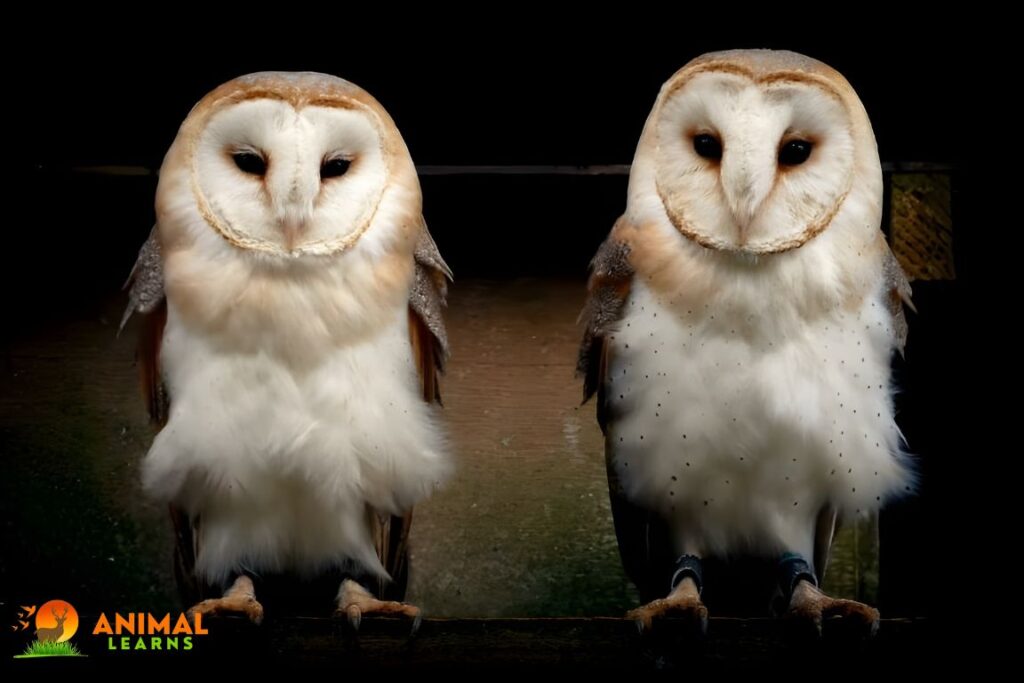
- Scientific name – Tyto furcata
- Lifespan – 10 years (average)
- Size – 34 to 38 cm (13 to 15 in)
- Weight – 400 to 600 g (0.88 to 1.3 lbs)
- Wingspan – 29 to 36 cm (11 to 14 in)
The face of a barn owl, also known as a church owl, ghost owl, or monkey-faced owl, is heart-shaped and has a dark brown border.
An interesting fact about owls is that their faces direct sound into their ears, making them the most effective hunters by sound that has ever been studied.
They can easily find tiny creatures beneath thick snow or brush thanks to their excellent hearing, and they even go bat hunting!
Barn Owls come in almost forty distinct types. The widest variety is the American (Tyto furcata), weighing 555 grams (1 pound, 4 ounces), while the smallest species is found in the Galapagos Islands, with 260 grams (9.2 ounces).
Nesting
Typically, American Barn Owls are monogamous, meaning they only have one lifelong companion. When the time comes to build a nest, which is normally in March or June, the male will locate a suitable location, which is typically a cliffside, a huge hollow in a tree trunk, or a nesting box.
After that, he will circle the area that designates his domain as he waits for the female to join him. Before it’s time to reproduce, he will start following the female and swooping around her as soon as she joins him.
Diet
Roughly 90% of the American Barn Owl’s diet consists of voles and shrews in North America, where it only hunts at night.
The American Barn Owl’s ears are not positioned symmetrically. Because of this, it can hunt in total darkness and use its hearing to pinpoint the precise location of its victim.
The American Barn Owl needs more food to survive since it has a faster metabolic rate than other owls of its size.
Where to look for them
The majority of Wisconsin is home to American Barn Owls, however, they are more common in the state’s northern forests. Finding an open grassland on a calm day boosts your chances of seeing a barn owl because these birds dislike high winds.
If you’re searching for them in the summer, try staying up late and searching for them around dusk or rising early and searching for them around dawn.
They will typically prolong their hunting hours in the winter, allowing you to see them during the day.
In contrast to other owls, they emit an extremely loud screaming sound instead of the typical owl “hoot.” You won’t miss this terrifying sound if you hear it!
Barred Owl
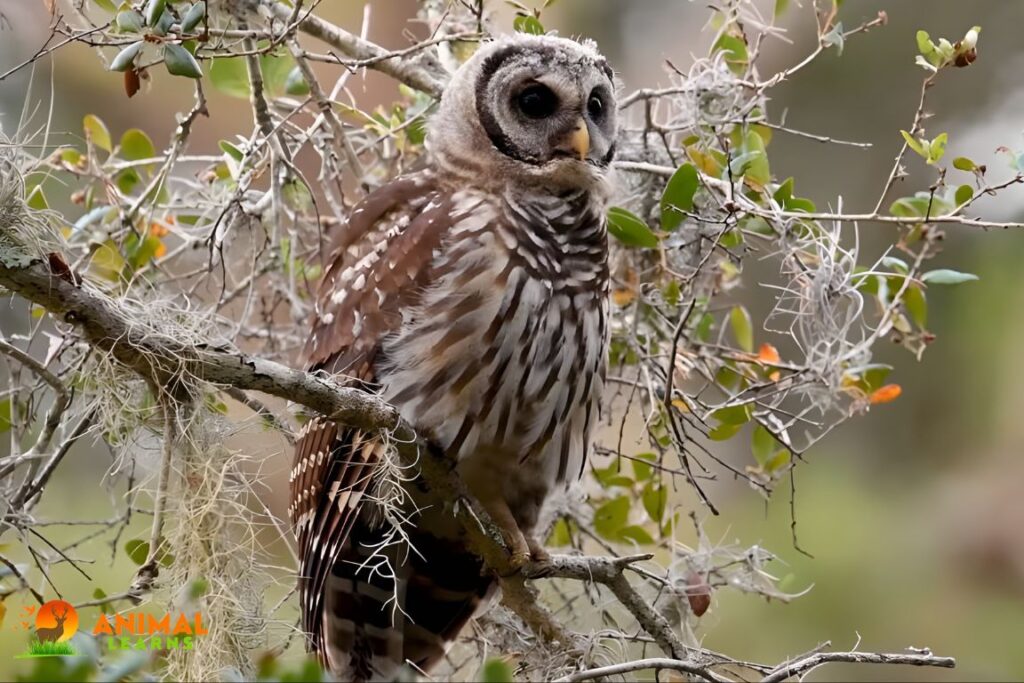
- Scientific name – Strix varia
- Lifespan – 8 years (average), 26 years (maximum recorded)
- Size – 16.9 to 19.7 in (43 to 50 cm)
- Weight – 16.6 to 37 oz (470 to 1050 g)
- Wingspan – 39 to 43.3 in (99 to 110 cm)
In comparison to other owl species, Barred Owls have incredibly tiny territories and do not migrate. Not a single owl that was banded and later located in a survey of 158 of them had traveled more than six kilometers.
The Barred Owl is widespread over the majority of the eastern states and southern Canada, despite its narrow range and lack of spirit of adventure.
The whole body of the Barred Owl is brownish-grey, with black stripes running down its underside.
Nesting
Barred Owls form lifelong pairs and are monogamous, just like American Barn Owls. When choosing a mate, the male will begin to bow and nod toward the female while spreading his wings, anticipating her acceptance.
In February, the Barred Owls begin their courting rituals. After mating, Barred Owls build their nests on hollow tree trunks in deep, gloomy woodlands.
Diet
Hunting in the woodlands are the Barred Owls. They glide from tree to tree while perched on branches, searching for food.
Its typical diet includes fish and small birds, but small animals make up the majority of its prey. They usually hunt around marshes and woodland rivers.
Where to look for them
Wisconsin is home to barred owls, which are most widely distributed in the western regions west of the Wisconsin River.
They are nocturnal animals as well, and it is best to locate them around dawn or dusk. The greatest areas to locate this bird are around lakes and rivers in bottomland woods.
Eastern Screech Owl
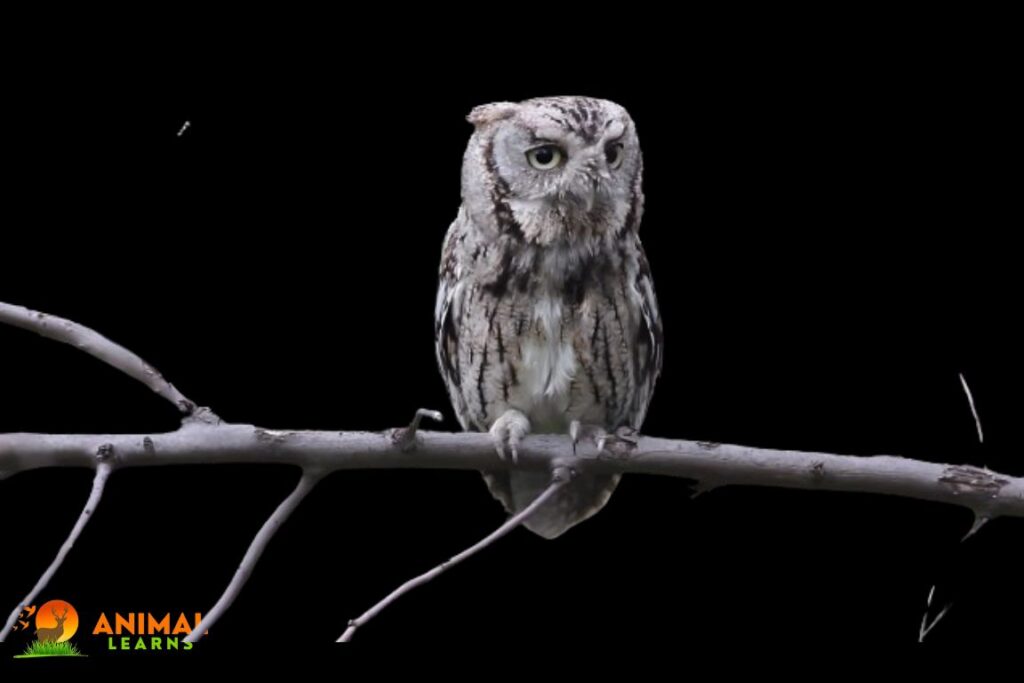
- Scientific name – Megascops asio
- Lifespan – 4 years (average), 14 years (maximum recorded)
- Size – 6.3 to 9.8 in (16 to 25 cm)
- Weight – 4.3 to 8.6 oz (121 to 244 g)
- Wingspan – 18.9 to 24 in (48 to 61 cm)
The human species does not terrify the Eastern Screech-Owl. It has done a fantastic job of adapting to human growth. It may be found throughout the eastern states and even in Mexico.
The southern population of the bird appears to have a more reddish color morph, whereas the northern group has a more grayish color morph. The hue of the woods where they live appears to be the cause of this color shift.
Nesting
The majority of the year, the Eastern Screech Owl lives alone; sightings of a couple occur primarily during the mating season, which begins in April. Following mating, barred owls in deep, dark forests will build their nests in hollow tree trunks.
The Eastern Screech-Owl often pairs for life and is monogamous. However, it is known that some males mate with two separate females. Typically, the second female pushes the first one out of the nest and lays her eggs.
Diet
Typically, the Eastern Screech Owl hunts around open forests, open fields, and marshes. In contrast to other owls on this list, the Eastern Screech Owl mostly eats insects and worms. Nonetheless, they continue to eat a steady portion of small animals.
Where to look for them
The southern regions of Wisconsin are home to the Eastern Screech Owl. Like other nocturnal owls, they will hunt along the borders of woodland during the night.
They prefer to sleep at the entrance of tree cavities or nest boxes, so if you search for them during the day, you could be lucky and discover them there.
Long-eared Owl

- Scientific name – Asio otus
- Lifespan – 11 years (average), 27 years (maximum recorded)
- Size – 13.8 to 15.8 in (35 to 40 cm)
- Weight – 7.8 to 15.3 oz (220 to 435 g)
- Wingspan – 35.4 to 39.4 in (90 to 100 cm)
Across the world, the Long-eared owl is one of the most widespread and abundant owl species. This bird’s brown and black plumage blends in nicely with pine trees, giving it excellent camouflage for its surroundings amid dense forest.
Even in deep forests, this bird’s sounds may be heard up to a mile away, so forest visitors are familiar with it.
Nesting
Being monogamous, Long-Eared Owls begin to breed around March. The female will search for potential nesting sites, while the male will mark his territory by clapping his wings and singing.
They frequently use ancient hawk nests or crevices in old tree trunks as their nests, just like the majority of other owls.
Diet
The Long-Eared Owl makes its nests in thick foliage, but at night it ventures out to hunt in more open regions.
They eat almost exclusively voles; they only switch to eating other small animals and birds during really terrible vole years.
Where to look for them
While they may be found across much of Wisconsin, the Long-eared Owl is most common in the southeast, particularly in the areas between Sheboygan and Madison.
These owls are among the best disguised on the list, which makes it very difficult to locate them. If you decide to go in search of them, a good place to seek them is among pine stands that are near meadows or grasslands, as this is where they often roost.
The owls will gather in huge groups in a single tree to sleep in the winter, which will make them simpler to locate. So a good approach to spot a possible roosting tree in the winter is to look for bird pellets and droppings.
Great Gray Owl

- Scientific name – Strix nebulosa
- Lifespan – 13 to 27 years(maximum recorded)
- Size – 24 to 33 in (61 to 84 cm)
- Weight – 1.28 to 4.19 lb (580 to 1,900 g)
- Wingspan – 4ft 8in to 5ft (142 to 152 cm)
The Great Gray Owl is a ghostly giant among the Owls of Wisconsin. In terms of length, the Great Gray Owl is the biggest owl on the planet.
This owl is found across the northern regions of the planet and is around the size of a child between two and three years old. The name of the bird comes from its huge, round head, which has a grey face and dark streaks on the underparts.
The top parts of the bird are likewise gray. The massive bird is primarily composed of feathers, with the Snowy Owl weighing more despite its size. Because of this, the Great Gray Owl’s flight is incredibly silent.
Nesting
Because they are monogamous, owls in deep forests begin to mate around March. They will use the nests of other birds or the enormous cavities in dead tree trunks, much like other owls.
To aid in population growth, great efforts have been undertaken in recent years to expand the number of artificial nests for this species.
Many states and non-governmental organizations began creating platforms and cavities for the birds to breed in the 1970s.
Diet
The Great Gray Owl listens for tiny animals to prey on, and it consumes them nearly exclusively. They can discover and capture anything that is moving under 60 cm (2.0 ft) of snow thanks to their superb hearing.
Although they are not fussy eaters like other owls, they do have a preferred animal based on where they live. Lemmings are often the main food source for birds in the north, whereas voles are preferred by birds in the south. But if their favorite prey is scarce, they will change their diet.
Where to look for them
Wisconsin is the southernmost extent of the Great Gray Owl’s range, with most of its sightings occurring in the northwest portion of the state.
During the day, they are typically located inside the holes in dead trees, just at the edge of woodlands. It’s really difficult to identify the holes despite their size because of how well-camouflaged they are.
They are most active around dusk and morning, so if you want to spot them while hunting, head to the same locations.
Short-eared Owl
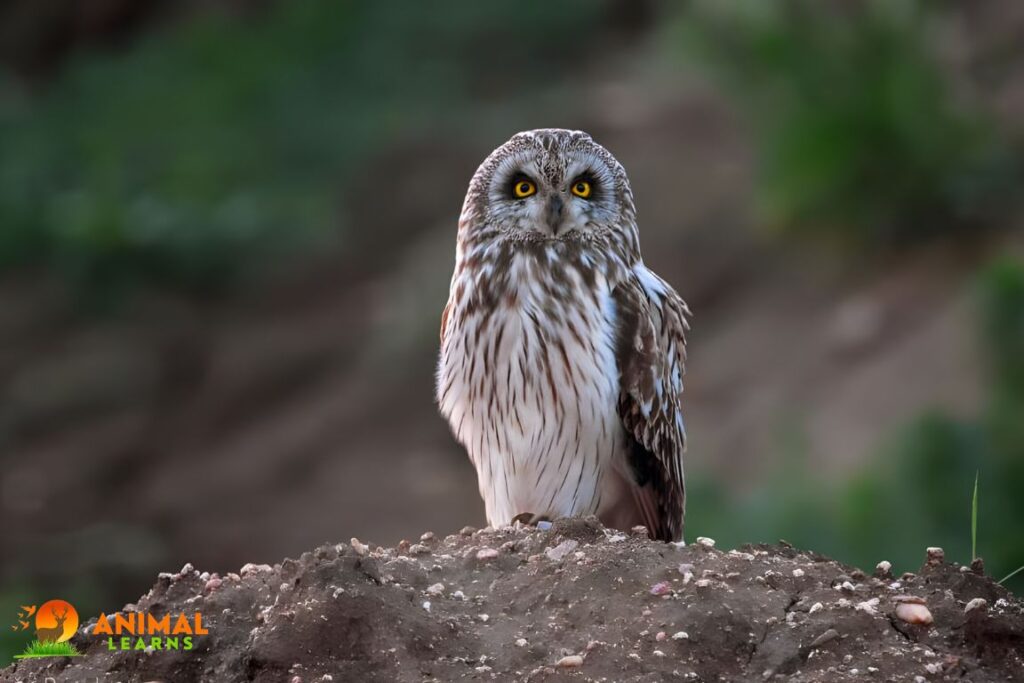
- Scientific name – Asio flammeus
- Lifespan – 4 years (average), 12 years (maximum recorded)
- Size – 13.4 to 16.9 in (34 to 43 cm)
- Weight – 7.3 to 16.8 oz (206 to 475 g)
- Wingspan – 33.5 to 40.5 in (85 to 103 cm)
One of the most common owls in the world, the Short-Eared Owl is found throughout the world. Its body is speckled with brown, its tail is barred, and it has short, black wings.
The breast feathers have a pale belly and are brownish. In contrast to its reputation, the Short-Eared Owl hunts throughout the day and is primarily seen during daytime hours.
Nesting
Due to their serial monogamous nature, which begins in March, couples of Short-Eared Owls remain together for the duration of the breeding season.
This owl, in contrast to others, prefers to congregate in groups and builds its eggs on the ground in sparsely vegetated regions like tundras, meadows, and grasslands.
Diet
The Short-Eared Owl hunts day and night, swooping low over wide-open spaces in search of its meal. Voles are their favorite food, the same as those of many other owls.
When vole numbers are low, they usually start by consuming other small animals before moving on to frogs and birds.
Where to look for them
The southern regions of Wisconsin are home to the Short-eared Owl, particularly the forests around the woods west of Madison and the Lake Michigan shoreline.
The Short-Eared Owl is more common during the day than the other owls on this list. They live largely in grasslands and open fields, where they go hunting at nightfall and sunrise.
They frequently hunt in a circle, so if you’re patient enough, they could come back to the same spot!
Northern Saw-whet Owl
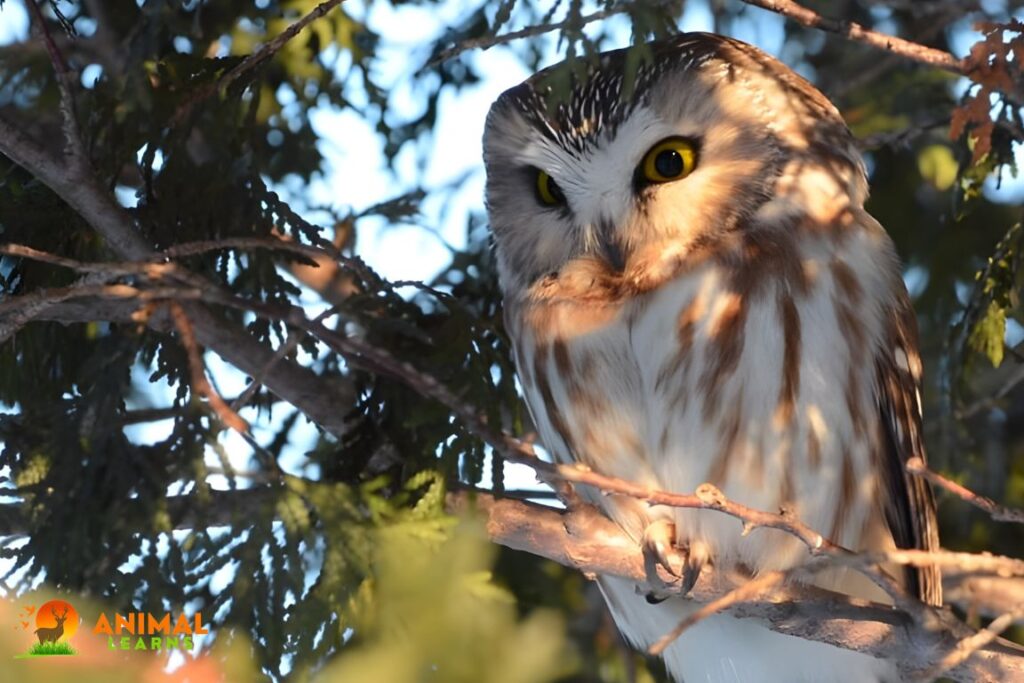
- Scientific name – Aegolius acadicus
- Lifespan – 4 years (average), 10 years (maximum recorded)
- Size – 7.1 to 8.3 in (18 to 21 cm)
- Weight – 2.3 to 5.3 oz (65 to 151 g)
- Wingspan – 16.5 to 18.9 in (42 to 48 cm)
This owl can be best described as little and timid. It is among the rarest and tiniest kinds of birds found in North America. The round, white face of the Northern Saw-Whet Owl is speckled with brown.
Their eyes are bright, and their beak is quite black. The upper portion is deeper brown with whitish dots, while the belly is light with brownish blotches.
The owl’s name appears to have originated from the sound of its cry, which is like a saw being sharpened with a whetstone.
Nesting
Due to their serial monogamous nature, which begins in March, couples of Northern Saw-Whet Owls remain together for the duration of the mating season.
Males will occasionally mate with many females during a breeding season when accessible prey is abundant.
The old woodpecker holes, tree trunk holes, and nest boxes are where owls will build their nests.
Diet
This bird feeds animals nearly entirely, with a preference for deer mice, and voles. They appear to have a different diet in more humid environments, such as those near rivers and wetlands, where they will consume more insects, frogs, and crustaceans.
Where to look for them
Due to its small size and secretive nature, the Northern Saw-whet Owl is difficult to locate. The northern regions of Wisconsin are a great spot to seek for this bird because they often live in dense forests.
These birds are little, so the easiest method to find them is to listen to their sounds. They stand out from other bird cries since they have a sound that is almost like a miniature vehicle backing up.
Snowy Owl

- Scientific name – Bubo scandiacus
- Lifespan – 10 years (average), 24 years (maximum recorded)
- Size – 20.5 to 27.9 in (52 to 71 cm)
- Weight – 56.4 to 104.1 oz (1600 to 2950 g)
- Wingspan – 49.6 to 57.1 in (126 to 145 cm)
One of the most well-known owl species is the snowy owl, which breeds in the Arctic and spends the winters in North America. The Snowy Owl, as its name suggests, is one of the world’s purest white creatures.
It is very white. While the ladies have more black feathers mixed in with the white ones, the males tend to be more white. The Snowy Owl, unlike the other owls on this list, can be active throughout the day or night.
This may be because it is an arctic bird, living in a region where summer days are very long and winter days are short.
The Snowy Owl is a highly migratory bird that travels great distances from its breeding grounds to its wintering grounds. Its wintering sites vary in distance south every year.
Nesting
By April, the Snowy Owl has made its way to the polar tundras, where it will start its mating rituals. The male will select a location, typically a shallow hole in the open tundra, and start singing while performing aerial stunts for the enjoyment of the ladies.
Additionally, he will provide food to a female who expresses interest and kneel to her while demonstrating the nesting place.
The female owl may scrape the floor of the nesting place to create a small hole for the eggs to lay in, but she won’t build a true nest.
Diet
Their nutrition fluctuates as much as their environment does during the mating season and the winter. They are primarily nocturnal throughout the winter, when they hunt for water birds like teal and northern pintails as well as small animals like rats.
Since lemmings make up the bulk of the owl’s food supply, lemmings make up the great majority of their diet throughout the summer at their nesting sites.
Where to look for them
This owl only spends the winter in Wisconsin since it breeds in the high Arctic. To prepare for the mating season, they will spend their time here hunting in open spaces like fields and shorelines.
The greatest places to search for this bird in Wisconsin are to the east and south due to its hunting tendencies.
When observing a level snowy field, it is simple to overlook this bird since it fits in so well with the wintry Wisconsin scenery.
Northern Hawk Owl
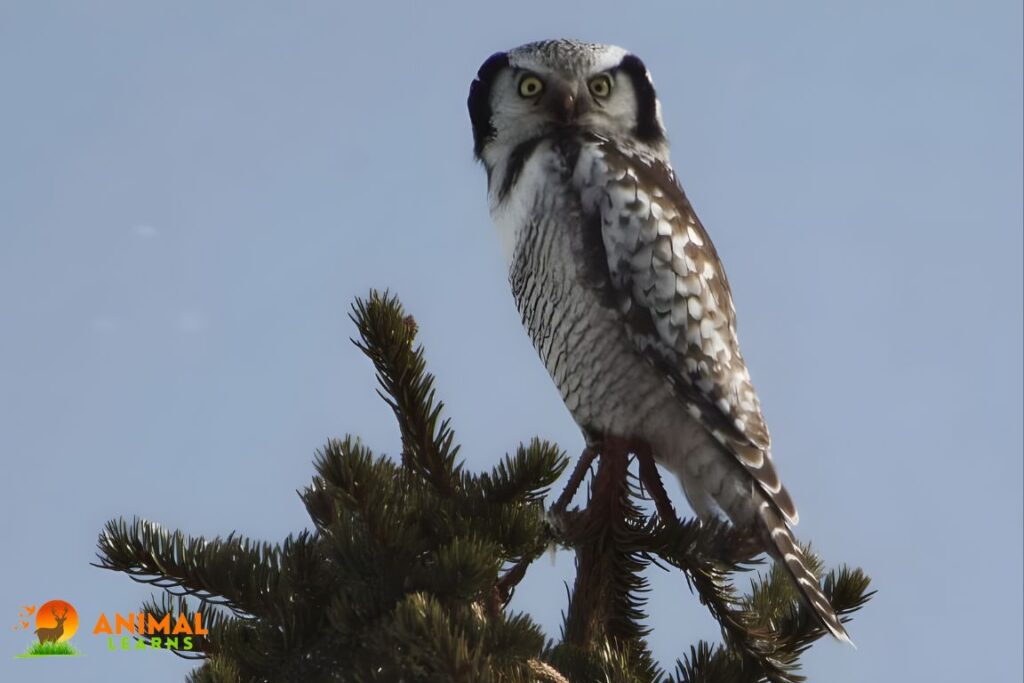
- Scientific name – Surnia ulula
- Lifespan – 10 years (average), 16 years (maximum recorded)
- Size – 14.2 to 17.7 in (36 to 45 cm)
- Weight – 8.5 to 16 oz (240 – 454 g)
- Wingspan – 30.8 to 34.6 in (78 to 88 cm)
The Northern Hawk Owl, as its name suggests, is a hawk-like bird of prey that inhabits the northern regions of North America. It likes to sit high in trees or on poles, scanning for food, much like a hawk, as can be seen in the photo.
The body of the Northern Hawk Owl is dark brown with pale patches in some areas. The abdomen is likewise pallid. Its lengthy tail resembles that of a hawk. It has a pale face with a black border.
Nesting
Due to their serial monogamous nature, Northern Hawk Owls often establish couples and remain together for the whole of the breeding season, which begins in March.
The Northern Hawk Owl, in contrast to the other owls on this list, builds its nest after mating, typically utilizing an existing nest as the frame. After that, the male will fiercely defend the nest until the chicks have left.
Diet
Small animals like voles, red squirrels, and mice make up most of their food, although they also like eating birds and amphibians.
Where to look for them
When it ventures south, the Northern Hawk Owl may be observed over the majority of Wisconsin. They are frequently confused for hawks when they are sitting in broad, open spaces throughout the day on top of trees and poles.
Remember that the next time you see a bird you could mistake it for a hawk!
Boreal Owl

- Scientific name – Aegolius funereus
- Lifespan – 16 years (maximum recorded)
- Size – 8.7 to 10.6 in (22 to 27 cm)
- Weight – 4.6 to 6.3 oz (131 to 179 g)
- Wingspan – 20 to 24 in (50 to 62 cm)
This little owl leads a solitary life deep in the forests of North America. The upper part of the animal is brown, accompanied by white patches on the shoulders and a grayish belly streaked with rust.
Because of its shyness and secretiveness, this bird is rarely seen by people, and as a result, not much is known about it.
Nesting
Usually, the nests are just old holes that woodpeckers dug and left behind. Because they are monogamous, owls in deep forests begin to mate around March.
Diet
Their primary food source is small animals like voles and mice, but when they live near wetter environments like wetlands or rivers, they are also eager to consume birds and amphibians.
Where to look for them
Finding this bird at night requires being in the deep, dark woods because it is purely nocturnal. When not hunting, they are typically seen sitting in perfectly camouflaged fir trees 20 feet above the ground, either inside or extremely close to the tree trunk.
The Owls of Wisconsin weave a tapestry of mystery and wonder upon the night breezes, eternally enchanting anyone who dares listen to their ancient song.
Their sounds range from the subdued hoots of the Barred Owl in mossy bogs to the haunting gaze of the Great Gray Owl ruling over frigid woods.
Conclusion
One of the finest places to search for owls is Wisconsin. It is very difficult to not see at least one of the state’s many owl species, which range in habitat from north to south and east to west. The state is home to the majority of the country’s native owls.
Since many owls are active even in broad daylight near human civilization, some are easier to observe than others, and many don’t even need much effort.
Experienced owl hunters will have plenty of chances to search for some of the rarer species in Wisconsin, such as the Boreal Owl and the Snowy Owl.
FAQs
What is the most common owl in Wisconsin?
In Wisconsin, the most common year-round owl is the Eastern screech owl. This little owl, which has a characteristic call, is found in parks, backyards, and woodlands, among other places.
What is the rare owl in Wisconsin?
A rare species of owl, the Snowy Owl spends the winter migrating south to Wisconsin. They are big, white owls with golden eyes that are usually spotted in wide-open spaces or along the sea.
What do Wisconsin owls eat?
A wide range of tiny creatures, including mice, voles, rabbits, birds, and insects, are consumed by Wisconsin owls. An owl’s specific food varies depending on its species and the environment it inhabits.
Does Wisconsin have snowy owls?
Indeed, as was already noted, throughout the winter, Snowy Owls move south to Wisconsin.
Does Wisconsin have barn owls?
Although they are distributed across Wisconsin, barn owls are more prevalent in the southern region of the state. They are heart-shaped-faced, medium-sized owls that hunt in wide-open spaces and grasslands.
How many species of owls live in Wisconsin?
11 species of owls live in Wisconsin.



